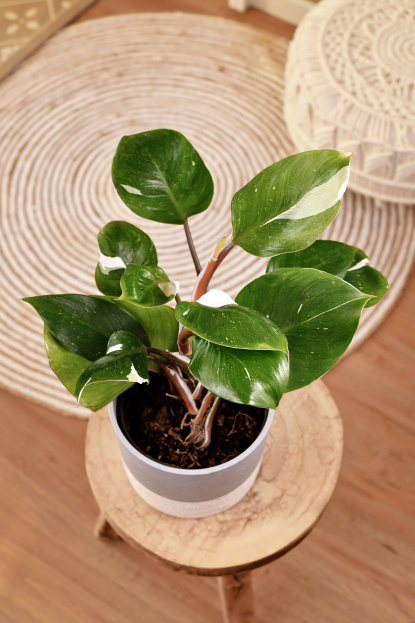
The Philodendron White Knight is a stunning and rare cultivar of the popular Philodendron family. Known for its striking, variegated leaves that feature a mix of white, cream, and green hues, the White Knight is a sought-after plant among collectors and plant enthusiasts. Its elegant appearance and relatively easy care requirements make it an excellent choice for indoor gardening. If you’re lucky enough to own one of these beauties, here’s what you need to know about how to care for your Philodendron White Knight.
Philodendron White Knight thrives in bright, indirect light. The variegated foliage needs ample light to maintain its beautiful white and cream patterns. However, it’s important to avoid direct sunlight, as this can scorch the delicate leaves. If your plant doesn’t get enough light, the white areas may turn green, and the variegation will be less pronounced.
Place your Philodendron White Knight near a window that gets bright, filtered light—an east or west-facing window is ideal. If natural light is limited in your living space, consider using a grow light to provide the necessary brightness for healthy growth.
Philodendron White Knight prefers moderate watering. Like many tropical plants, Philodendron White Knight doesnt like to sit in water, so ensure the pot has good drainage to prevent root rot. Water your plant when the top 1 to 2 inches of soil feel dry to the touch. During its growing season (spring & summer), the plant may need more frequent watering, while in the fall and winter, you can reduce watering as the plant’s growth slows down.
Be sure not to overwater, as this can lead to root rot and other issues. Always check the soil moisture before watering, and make sure the excess water drains away properly.
Philodendron White Knight thrives in warm and humid conditions. Philodendron White Knight prefers temperatures between 65°F and 80°F (18°C to 27°C), so keep it away from cold drafts, air conditioners, and heaters.
Humidity is essential for the plant’s well-being, as it is native to tropical regions with high moisture levels. Aim for a humidity level of at least 50% to 60%. If the air in your home is dry, especially during the winter months, consider using a humidifier, placing the plant on a humidity tray, or misting the leaves regularly to maintain adequate moisture levels.
Philodendron White Knight prefers well-draining, lightweight soil. A good mix for this plant would be a combination of peat, perlite, and orchid bark, which will provide the necessary drainage and aeration. The soil should remain slightly moist but never soggy.
When repotting, choose a pot that is 1 to 2 inches larger in diameter than your current one. Ensure that the pot has drainage holes to prevent water from accumulating at the bottom, which can cause root rot or pests. Repotting every 1 to 2 years or when the plant becomes root-bound will help ensure its continued growth and health.
During the growing season (spring and summer), you can fertilize your Philodendron White Knight once a month with a balanced, water-soluble fertilizer diluted to half strength. This will encourage healthy growth and vibrant variegation. Be careful not to over-fertilize, as this can cause fertilizer burn and stress the plant.
In the fall and winter, reduce fertilization since the plant’s growth slows down during the dormant period. Over-fertilizing during this time can lead to nutrient buildup in the soil, which can harm the plant.
Philodendron White Knight is relatively low-maintenance, but occasional pruning can help keep the plant healthy and promote bushier growth. If the plant becomes leggy or develops long vines, you can prune it back to encourage new growth. Using clean, sharp scissors or pruning shears to cut just above a visible node (the point where leaves and stems emerge).
For propagation, you can take a stem cutting with at least one node and place it in water or moist soil to root. Once the cutting has developed roots, you can transplant it into its own pot. Keep in mind that the White Knight can be slow-growing, so patience is key.
No, Philodendron White Knight is not pet-safe. Like other Philodendron species, it contains calcium oxalate crystals, which are toxic to pets if ingested. If a pet chews on or swallows any part of the plant, it can cause mouth irritation, drooling, and digestive issues. Keep your Philodendron White Knight out of reach of pets to ensure their safety.
The easiest way to distinguish between these three variegated philodendrons is by examining their stems: